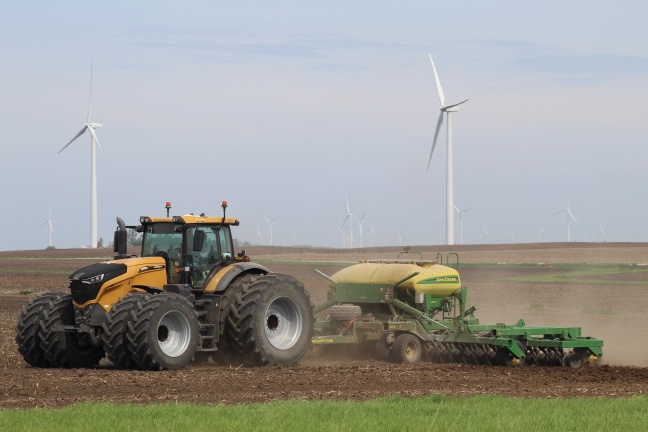
A farmer plants soybeans on a central Iowa field in May 2022. Photo by Chris Kick/ISU Extension and Outreach. Larger image.
AMES, Iowa – As corn and soybean farmers in Iowa begin spring planting, drought remains a concern and market conditions suggest profits will be tight. Iowa State University agricultural experts are available for media interviews on a variety of issues. Here’s what three of them are thinking about the 2024 growing season:
Chad Hart, professor of economics and ISU Extension and Outreach grain markets specialist
Following a bumper 2023 harvest that outpaced demand, prices for corn and soybeans planted this spring are expected to drop for the second year running. That leaves farmers with little financial wiggle room, but falling expenses will help. Projected 2024 production costs are within a dime per bushel of prices for both crops. The price of inputs such as fertilizer often fall with crop prices, but the correction takes a year or two, Hart said.
“We’re basically sitting where we should be, in the long run,” he said. “Farming is a competitive industry. In competitive industries, your prices tend to be around your production costs.”
Break-even prices put the squeeze on farmers, making ideal selling situations harder but not impossible to find, Hart said.
“Just because the average is around zero doesn’t mean everyone makes zero,” he said. “There are going to be a few weeks out of the year where farmers can make a good profit. Those who can do that will be more successful.”
Thin profit forecasts tend to nudge farmers from corn to soybeans to hedge risk, as it costs less to grow on a per acre basis, Hart said. That helps explain the projected 2.9 million acre increase in U.S. soybean fields, compared to a 4.6 million acre drop for corn. Surging demand for renewable diesel also encourages expanded soybean production, with biofuels set to replace exports as the market’s biggest driver in the coming years, Hart said.
Mark Licht, associate professor of agronomy and ISU Extension and Outreach cropping systems specialist
Strong yields are especially important when margins are slim, and the first step to high-end production is prompt planting. So far, Iowa’s weather has been cooperating, with adequate rainfall and warmth. As of April 21, 13% of the state’s expected corn crop and 8% of soybeans were in the ground. That was three days ahead of schedule for corn and six days ahead for soybeans, based on the previous five years.
Despite spring rains, most of the state is still in a drought, with northeast Iowa seeing the worst conditions. Licht said topsoil moisture should be sufficient for crops to establish in most areas. In many areas of Iowa, however, the subsoil remains dry and will need prolonged, steady precipitation to recover. Without that buffer, getting moisture at just the right times will be crucial this summer. Rain in mid- to late-July would help corn during pollination, while mid-August rain would give soybeans a boost in their seed-filling stage.
“Timely rain could really swing things for farmers this summer,” he said.
After Iowa’s warmest winter on record, early field scouting is a good idea in 2024, Licht said. Insect, weed and disease pressure could crop up earlier than usual, though seed treatment should prevent widespread issues.
“We probably have an increased risk, but we have so much protection already that we may not even notice it,” he said.
Madelynn Wuestenberg, ISU Extension and Outreach agricultural climatology specialist
While above average precipitation this spring is helping, Iowa is about to mark 200 consecutive weeks with at least some portion of the state in drought status, an unusually long dry stretch. In northeast Iowa, cumulative rainfall since 2020 is 30 inches short of historical averages, nearly an entire year’s worth of precipitation, Wuestenberg said.
“Even if we had a perfect year, it would not be enough to overcome a 30-inch rainfall deficit. It’ll need to come slow and steady,” she said.
Slow and steady is becoming less common, though. Wuestenberg said Iowa rainfalls are getting heavier and less frequent, leading to less soil absorption and more runoff.
“Iowa weather is trending more extreme and variable. We’re also seeing our hots getting hotter and our colds getting colder,” she said.
Stronger heat waves in the summer can put around-the-clock stress on crops, as elevated overnight temperatures inhibit recovery from dry and hot days, Wuestenberg said.
“Crops really rely on those cooler evenings,” she said.


